
 Want to look thinner? Taller? Tanner? Don't worry, there's a camera for all that. Today's cameras will let you do more than adjust the flash; they'll let you adjust reality. Photo-adjusting features that once required a PC and special know-how are now allowing consumers to alter a photo as soon as it's snapped.
Want to look thinner? Taller? Tanner? Don't worry, there's a camera for all that. Today's cameras will let you do more than adjust the flash; they'll let you adjust reality. Photo-adjusting features that once required a PC and special know-how are now allowing consumers to alter a photo as soon as it's snapped.
Some new Hewlett-Packard cameras include a feature that makes subjects look thinner, while another mode makes facial lines and pores virtually disappear. A "skin tone" feature on some Olympus models can give consumers a leisure-class tan. Other manufacturers offer modes to make the colors of the world richer as you capture them. Using these new in-camera tools, consumers can even crop out ex-boyfriends, or put a virtual frame around a new one.
Most digital cameras to date have had tools that remove red-eye from photos or lighten darkened images because of a poor flash. But that editing corrects a deficiency in the photographer's skills, or the camera itself, not the subject.
With new tools, average people can create their own "pictures that lie" at the moment of capture, without any trace of the real image that was seen with the naked eye.
"People in the legal world are now concerned about whether photos can be accepted as evidence anymore, especially when you can alter the scene as you click the shutter," said Peter Southwick, associate professor and director of the photojournalism program at Boston University. "And in the old days, there was an original, now there is no original. Photography as a tool for providing evidence, or as proof, may not exist anymore."
The late media and culture critic Neil Postman had famous criteria for all technology, noted Anthony Spina, an adjunct professor of sociology at Fairleigh Dickinson University in New Jersey who specializes in technology's impact on society.
HP recently released in-camera editing feature that makes a person appear more svelte. The tool, called "Slimming Mode," is part of HP's Design Gallery software, which is included on some of its Photosmart M and R series cameras. It compresses the center of a photo and stretches the edges to fix the aspect ratio.
The slimming tool doesn't target people specifically; it will elongate any object centered in the photo, with three degrees of slimness. Like most digital cameras with editing tools, the changed photo is saved as a copy, and the original image remains on the camera intact.
The idea came from the many people HP surveyed who said they hated having their picture taken. A personal trainer wanted to use the camera as a motivational tactic for her clients. Putting a good photo of the person on their refrigerator so they can say, 'I do want to look like this,' as opposed to the fat picture in a bathing suit," can be inspiring.
HP isn't the only manufacturer to offer this type of alteration feature. With the digital camera market maturing, manufacturers are using new features to entice customers to upgrade their current digicams. Canon, Kodak, HP, Nikon and Olympus all offer features that increase saturation, bumping up the richness of color "seen" by the camera. The photographer clicks and a sunset forever becomes more brilliant than it appeared in real life. Homegrown vegetables become more luscious.
"The consumer products and all these changes in photography, to me, are going to cause an undermining of people's ability to believe a photograph, which is the foundation of photojournalism," Southwick said. "Now that it is at the consumer level and people are going to see this, I am not sure on a fundamental level that they are ever going to believe a photo when they see it."
With photo-editing packages widely available, Southwick said he has seen a change over the years in people's attitude toward the integrity of photos. During lectures or speaking engagements, Southwick asks his audience how many people have heard of Photoshop.
Ten or 12 people used to raise their hands, but now everybody does. Still, as big as Photoshop's impact, Southwick said, in-camera photo-editing features will have an even greater effect on the way people relate to photography.
If pictures are indeed captured memories, as camera marketers would have consumers believe, these new features enable people to create a rosier vision of their personal history.
"It almost does contribute to people changing their identities, for whatever reasons they are motivated to do that," Spina said. "Particularly, I can see it being used on a dating service. Now you can say the picture is current and still lie.
But what I want to know is: What's going to finally happen when you meet that person? Even if you are not using it for that, its only interest is to make you look better. But why would you take a picture of yourself and give it to people who know you if it doesn't really look like you?"
But does it really matter? Photos have been "lying" for years in one respect or another. For example, photography from the 1940s, because it was black and white, gave a clean orderly appearance, with people in photos from that era appearing consistently crisp, with bright white teeth and seemingly matching outfits.
Spina said that he finds most technology of this nature as nothing more than entertainment. But he does see the trend leading to a larger philosophical question.
"Does social change drive technology change, or do changes in technology change social behavior?" he asked. "No one has won that debate...It just depends on where you fall on that continuum. My own personal bias is that technology advancements lead to social change."
Excerpt from Candace Lombardi for News.com
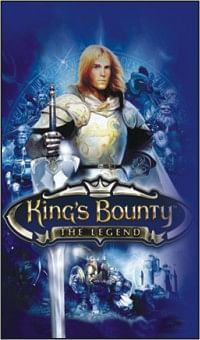
Long ago, before some of us were even born came out a computer game, which is pretty much obscure to most of us. In 1990, New World Computing released a tactical turn-based role-playing game with a little bit of strategy thrown in. This was called King's Bounty. It faded into the pages of gaming history though, but not before paving a path to a new series of games- the Heroes of Might & Magic series. The game play and style is very similar to it's forerunner- King's Bounty. What exactly are the gameplay and style, you say? I'll get to that.
But, now… Imagine a world- fill it kings and queens, creatures of myth and mystery, enchanted forests, dark cemeteries, sorcerers and witches, and knights and dragons. When you've filled them in, give them a makeover. King's Bounty The Legend has all of those things and more, and everything is quite simply very beautiful. Once you've entered the game, you'll feel like you're living out a fairy tale story, and quite frankly, it's just too damned fun to get out.
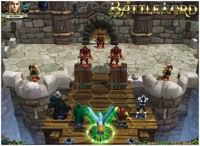 The story starts as a short tutorial, with your graduating from the Knight's Temple. You're able to select one of three classes at the start- Warrior, Paladin, and Mage. You then assume the role of “Royal Treasure Searcher” in the services of King Marc the Wise of Darion, from which you receive your main quests. There are also side quests aplenty.
The story starts as a short tutorial, with your graduating from the Knight's Temple. You're able to select one of three classes at the start- Warrior, Paladin, and Mage. You then assume the role of “Royal Treasure Searcher” in the services of King Marc the Wise of Darion, from which you receive your main quests. There are also side quests aplenty.
Quests can range from the usual killing of some monsters, fetching items, breaking curses or even hoisting a ruler's flag over someone's building. There are some serious bits in the game, and some silly bits in the game, but they're excellently blended in, and it makes no difference whatsoever, primarily because the game is that fun. Although, most of the gameplay is on land, you can travel by sea, too using a boat.
Combat is turn-based, and the hero (player) doesn't play a direct role in the fight. Rather, the combat is carried out by units of allies such as swordsmen, archers, priests, knights, dragons, vampires, etc etc- further assisted with his various hero attributes and skills are used. More attack and defense points improve units' damages and defense. And of course, what fantasy game would be fantasy without magic? Magic can be used to directly harm or hinder enemies, or make allies stronger.
Ally units are recruited from various places scattered throughout the world, like lords and ladies, witches and even gardeners. The amount of unit you can hire depends on your able to afford them with gold AND leadership. You can have five different units; with each unit possessing leadership points requirement, and the total for each unit cannot exceed your own leadership statistic.
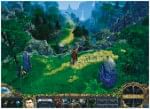 One of the prime charms of the game that made it so endearing are its graphics. It's not excessively amazing, and it doesn't have to be, but it's very good nonetheless with excellent animations for different creatures and spells. Seeing units like the Phoenix makes you wish you were really there, for real. There's a slight cartoony feel to it, and it shouts out loud the words, “Fairy tale!” to everyone playing the game. The visuals provide an excellent limelight for the rest of the game. The fire and water effects are very good, and the fireball spell really kicks like a mule.
One of the prime charms of the game that made it so endearing are its graphics. It's not excessively amazing, and it doesn't have to be, but it's very good nonetheless with excellent animations for different creatures and spells. Seeing units like the Phoenix makes you wish you were really there, for real. There's a slight cartoony feel to it, and it shouts out loud the words, “Fairy tale!” to everyone playing the game. The visuals provide an excellent limelight for the rest of the game. The fire and water effects are very good, and the fireball spell really kicks like a mule.
Yet another thing that makes you believe you're somewhere else is the music, which is also very cool but might come off as been taken from the generic fantasy music ranch, but it does complement the whole fairy tale thing very nicely, what with all the bardicness, and the fairies and enchanted princesses and the epic battles. However, it definitely lacks that certain kick.
Unlike other games, playing this one makes you feel like you're actuallly going somewhere with it, as if your achieving something. I suppose that's the purpose of RPGs, isn't it? But, yes. Anyway… King's Bounty: The Legend definitely has some issues, but its merits surpass them by far. Simple, kind of unique, kind of original, it takes you to a faraway non-existing land and makes you have a lot of fun with it. Don't miss this one, or you'll dream of electric sheep.
Reviewed By Emil
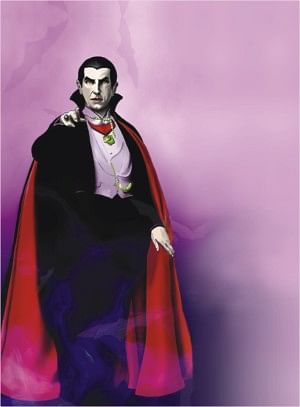

By The Dark Lord
The world was taken by storm, when an Irish writer, Bram Stoker, wrote the novel “Dracula” back in 1897. Featuring as its primary antagonist the vampire Count Dracula. Before “Dracula” the concept of mythological creatures was only restricted for some selected ones. But the new face of vampires not only unleashed a new era of dark force, but also gave birth to many vampire slayers, whose names are still taken with as much respect and admiration, as in the case of Dracula.
And as the topic comes down to vampire slayers, who's better than Professor Van Helsing himself - a Dutch doctor with a wide range of interests and accomplishments, partly attested by the string of letters that follows his name: “M.D., D. Ph., D. Litt. ,etc., etc." Although the character has been differently portrayed in films, they all represent the same person: the arch enemy of Count Dracula. Although the weapons of Van Helsing ranges from Bible, crucufix, holy water to Crossbow, Grappling-Hook Gun and Vampire Bomb, with the help of his allies Jonathan Harker, Quincy Morris, John Seward, Arthur Holmwood, and Mina Harker, he is a character who always gives the Count a run for his money!
And who is more worthy of stepping in Van Helsing's shoes than his own great-granddaughter Rachel van Helsing, who As a child, Rachel was witness to the murders of her parents at the hands of Dracula, in revenge for his defeat by Abraham Van Helsing. Rachel was subsequently raised by vampire hunter Quincy Harker, who was Dracula's most persistent enemy in the 20th century. The fight still continues for generations……..
If you take a peep at the TV screen, you may notice the dashing David Boreanaz, a.k.a Angel, from “Buffy the Vampire Slayer”. Like many characters in the Buffyverse, Angel goes through drastic changes, starting out as a reluctant hero who stayed in the shadows, and ended up an altruistic champion of mankind, seeking to voluntarily atone for his sins.
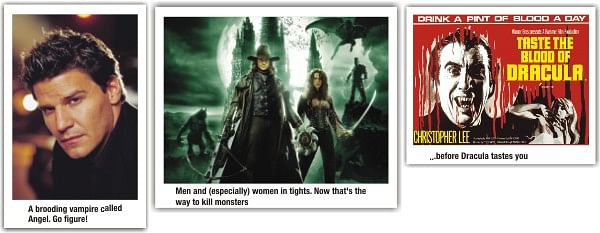
Garlic, holy water, crucifix and the Bible are good against vampires. But you there's no harm keeping the visiting cards of experts! Hellsing Organization - more formally known as the Royal Order of Protestant Knights. The Hellsing Organization was founded by Abraham Van Helsing shortly after the events of Bram Stoker's novel as a response to the threat posed by vampires after his encounter with the Count. It is traditionally headed by Abraham's descendants, as they are the only ones who can control Alucard, the ultimate undead created by the organization for use in their battles. As the Hellsing Organization's most powerful warrior, he serves as its special "trump card". He is not only a vampire, but also one of the most ancient ones, his original life dating back into the 1400s.
Yes, vampires may not exist anymore. But now you know whom you can rely on the next time Count Dracula or one of his descendants jump out and try to bury their fangs on your neck!
